No truth in photography? Photojournalist Ben Lowy on making (not taking) images
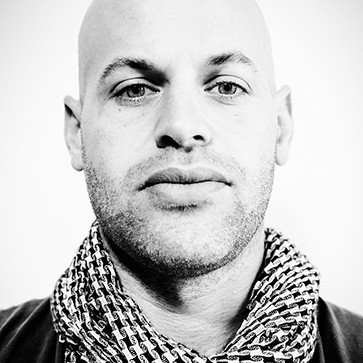

Whether it’s coming from photo school instructors or magazines, the advice for emerging photographers often strikes familiar notes: Don’t mix art and photojournalism. Find a niche. Develop a personal style to stand out from the crowd—and stick to it!
But not every pro has found success by following that kind of advice. We explored some alternative ways of thinking about image-making with a photographer whose approach has often defied convention, Ben Lowy. A veteran conflict photographer who first courted controversy by using an iPhone to cover war in Afghanistan and Libya, Lowy has employed a wide range of tools to cultivate an ever-evolving style. His subjects have been just as diverse, with his recent work focusing on sports, wildlife, and adventure photography in addition to journalism.
Lowy spoke with us about what he’s using to create his current work, how he adapts his style to connect with both subjects and viewers, and how his very different projects have informed each other. He also explained his process for creating the poignant black-and-white images featured in some of his recent series.
Aimee Baldridge: What do you think photographers can do to be prepared to capture the “decisive moment”?
Ben Lowy: I’m very much of the opinion that we are not supposed to take pictures but make them. That’s what separates a photographer from everyone else. You’re in control of what you see in front of you. You know the ins and outs of your camera, and you know how to control both technical and aesthetic aspects of it—not by affecting the scene; as a photojournalist, I don’t do that. But you know how to control all the elements you see in front of you. You line them up in your frame in order to appropriately tell the story, but also in order to create an aesthetic narrative that connects with your audience.
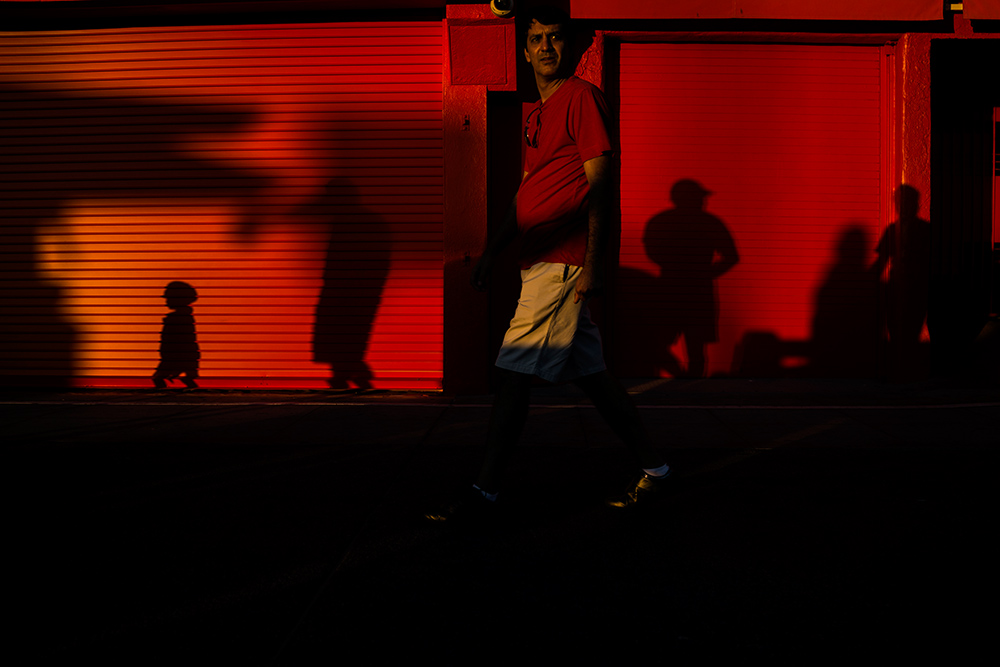
Visitors, tourists, and locals walk around the Venice Beach storefronts as the sun sets. Photographed with a Sony RX1R at ISO 50 with an f/4.0 aperture and 1/640 second shutter speed. Photo © Benjamin Lowy / Reportage by Getty Images.
AB: What does it mean in practical terms to be prepared to be in control of the situation?
Ben Lowy: I think it’s understanding how you take a picture, how you line things up, how you compose and read the light. It is about how you place yourself on the street, where you walk, what your background is going to be. These are all important things to think about when you go out and shoot, rather than just grabbing an image.
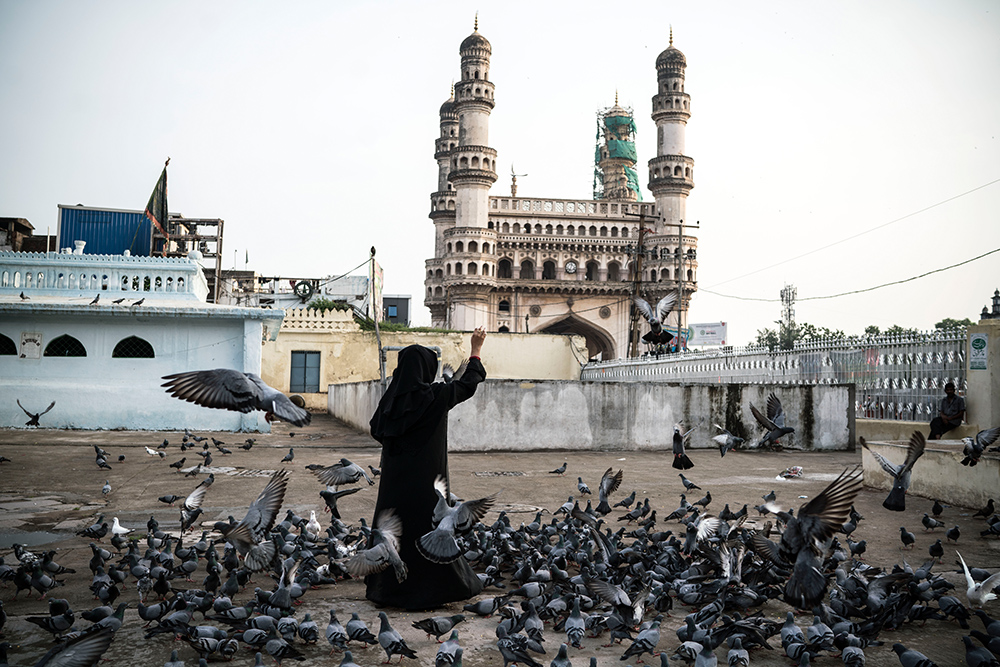
A Muslim woman feeds hundreds of pigeons at the famous Makkah Masjid in Hyderabad, India. Photographed with a Sony a7R II and Sony FE 35mm f/1.4 ZA Zeiss Distagon T* lens at ISO 400 with an f/4.0 aperture and 1/800 second shutter speed. Photo © Benjamin Lowy / Reportage by Getty Images.
AB: How is the way you place yourself on the street different from the way a snapshot photographer would?
Ben Lowy: It varies. I think it’s easier to explain when you’re enclosed in one particular space. For example, at Fashion Week, a lot of what I do when I go to those events is stand back and look at the space around me. I put my back to the wall and look at where people are and what they’re doing and what their movements are going to be, and try and figure out how I can create an image.
I tend towards a very clean visual. I hate having things poking out of the back of people’s heads or uncontrollable elements. So I try and find my way around things. I say, “OK, in order to make an image in this place, I want to shoot it from this angle.” And I place myself in that angle and wait for things to happen.
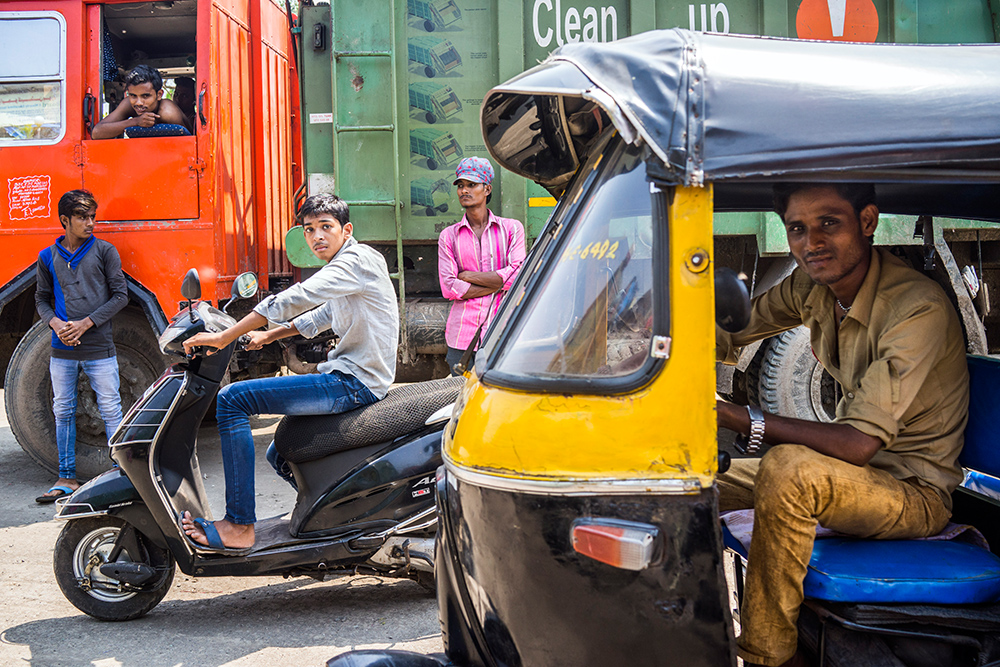
Residents and passersby watch Ben Lowy in Govandi, a slum that is arguably the poorest part of Mumbai, India. The population is estimated to be 800,000 to 1 million people crammed into the outskirts of a garbage dump and lacking basic sanitation. But even there, Lowy was welcomed and found himself the subject of innocent curiosity. "My tattoos are a big hit in India," says Lowy," and apparently so is my bald white head. Indians from all walks of life, rich and poor, are always taking selfies with me." Photographed with a Sony RX1R at ISO 640 with an f/5.0 aperture and 1/800 second shutter speed. Photo © Benjamin Lowy / Reportage by Getty Images.
AB: A lot of people think of photography as having the goal of being a transparent, objective medium. Are you saying that it’s not objectivity but your style that allows you to convey what you’re shooting?
Ben Lowy: There’s no such thing as truth in photography. Photography is artifice in general. You’re taking the three-dimensional existing world and flattening it. I think as a photojournalist, there’s this contract we have with the public to try to accurately portray the story around us in a truthful manner.
However, there’s a reason why I push the shutter button at the instant that I do, and it’s because I’m a product of all the experiences that I’ve had in my life before this one instant, and all those experiences influence and drive our decisions to take an image a certain way. We all have different reasons for why we shoot, and those things relate to our intent. Does that make the images we take more or less true? Not necessarily. It’s just a matter of the perspective I’m recording it from.
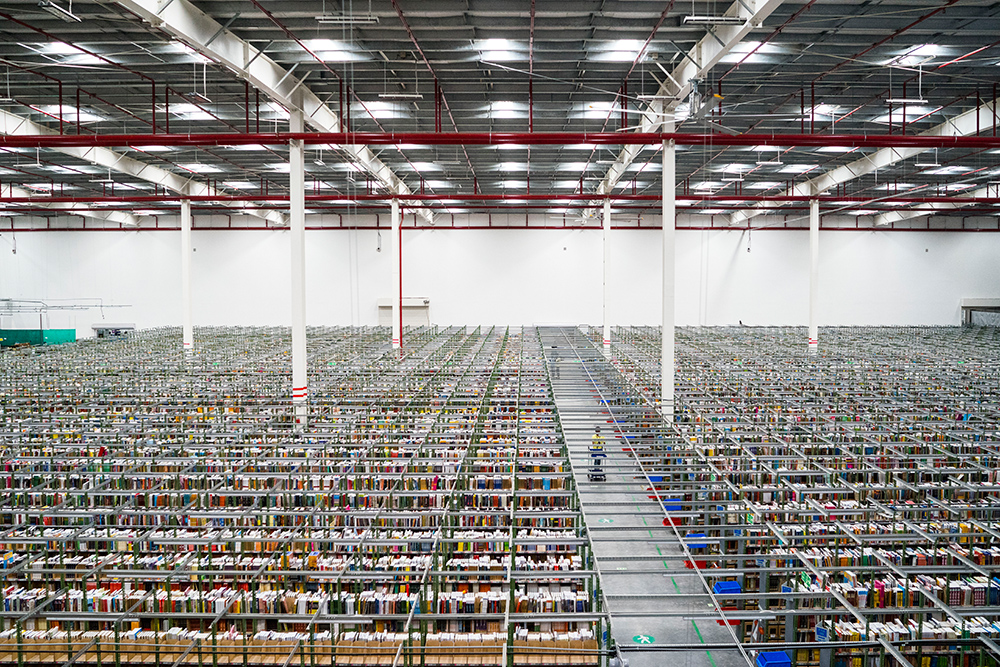
Row after row of every conceivable product, stored in one of the Amazon.com "Fulfillment Centers" outside of Hyderabad, India. Photographed with a Sony a7R and Sony FE 35mm f/1.4 ZA Zeiss Distagon T* lens at ISO 4000 with an f/4.0 aperture and 1/400 second shutter speed. Photo © Benjamin Lowy / Reportage by Getty Images.
AB: You’ve worked in so many different formats over the years—with all kinds of cameras and famously with an iPhone covering conflicts in Libya and Afghanistan. Would you say that your style is constantly changing?
Ben Lowy: One hundred percent. I think that if you don’t change, you stagnate. I was educated as a child and a teenager and even in college from the perspective of painting. My grandmother was a painter and my mother was a painter. No one painter kept a style. Even Picasso changed over the years.
I let each story that I work on talk to me and try and adapt to what I’m doing to create something that works for each piece and each idea that I’m trying to wrestle with. If I just shoot the same way day in and day out, year after year, then it becomes more about me than what I’m photographing. I very much like to create something that is about what I’m photographing just as much as it’s about me.
Using the iPhone as early as I did was a selling point for the work itself. It’s not that I couldn’t have made that work with a regular camera. It was the idea of connecting to the audience back home and saying, “That tool you have in your back pocket is what I’m using to shoot.” Maybe it brought the audience a little bit closer to the image and the content because they could imagine doing it themselves.
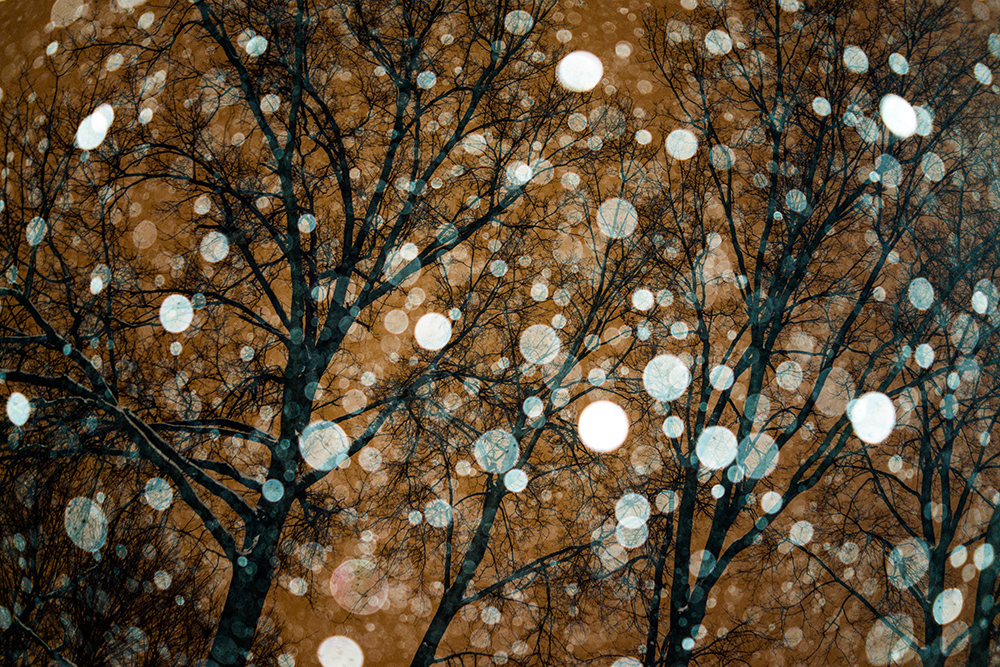
Snow in Paradise; Maplewood, New Jersey. Photographed with a Sony RX1R at ISO 200 with an f/2.0 aperture and 1/25 second shutter speed. Photo © Benjamin Lowy / Reportage by Getty Images.
AB: What are you shooting with these days?
Ben Lowy: I’m shooting with a lot of Sony cameras. I really like the RX1 line. I have the a7R II and the a7R. But the RX1R is sort of my favorite camera to use. It’s very small, and it has a viewfinder that allows me to look down. I’m a six-foot-tall person, and my pictures tend to look down on people a lot because I’m just taller if I’m holding the camera up to my eye. But having the RX1R with the viewfinder that tilts up at 90 degrees so I can look down puts me a little bit lower. I really like that. It doesn’t throw people off, because they don’t have a camera pointed at them by a person, like in front of my face. I’m kind of looking down. It makes a huge difference.
AB: That’s a full-frame fixed-focal-length camera.
Ben Lowy: Yeah. All I need is a 35mm lens. For me it’s the perfect angle. If I need to get closer I can walk and if I need to get farther I can back away.
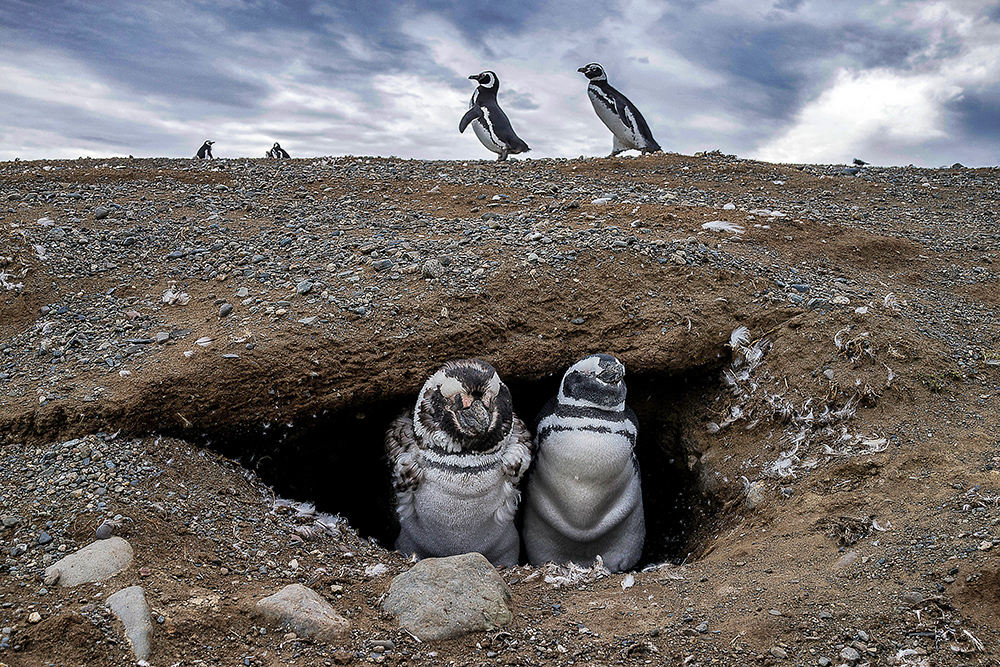
Adult Magellanic penguins on Magdalena Island, Chile, await the proper conditions to leave their small summer home for the winter months, their offspring having already migrated. Photographed with a Sony RX1R at ISO 640 with an f/14 aperture and 1/125 second shutter speed. Photo © Benjamin Lowy / Reportage by Getty Images.
AB: You’ve been shooting a lot of sports recently. Why have you been doing so much sports photography?
Ben Lowy: I find sports to be really interesting, coming from conflict photography. For me, sports is like the civilized world’s version of conflict resolution. Instead of going to war, we have it in the arena. I started by photographing cage fighting in America, and now I’ve expanded to traditional wrestling techniques around the world, trying to figure out that drive in man—mostly men—and how we deal with violence and conflict resolution. I’m not sure if it works.
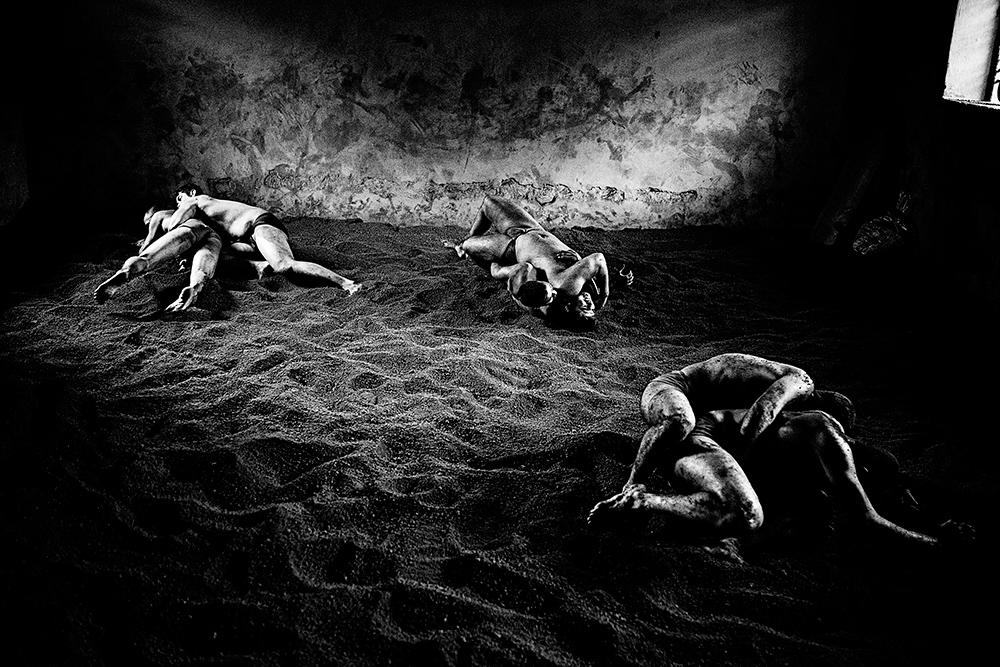
Indian Kushti wrestlers at daily practice in a talim (a wrestling center) in Kolhapur, India. Photographed with a Sony RX1R at ISO 1600 with an f/2.0 aperture and 1/500 second shutter speed. Photo © Benjamin Lowy / Reportage by Getty Images.
AB: Your sports images often have a very personal, almost introspective, feeling for me, which is not what I usually expect from sports photography.
Ben Lowy: Well, I’m kind of a failed athlete. At this point in my life I’m just really good at working out. I’m not good at doing anything; I’m just good at lifting weights. When you go to the gym, there’s a certain camaraderie with the guy next to you who’s working just as hard. I find that within groups in sports, there’s a distinct camaraderie among the participants, and you leave everything else in life at the door.
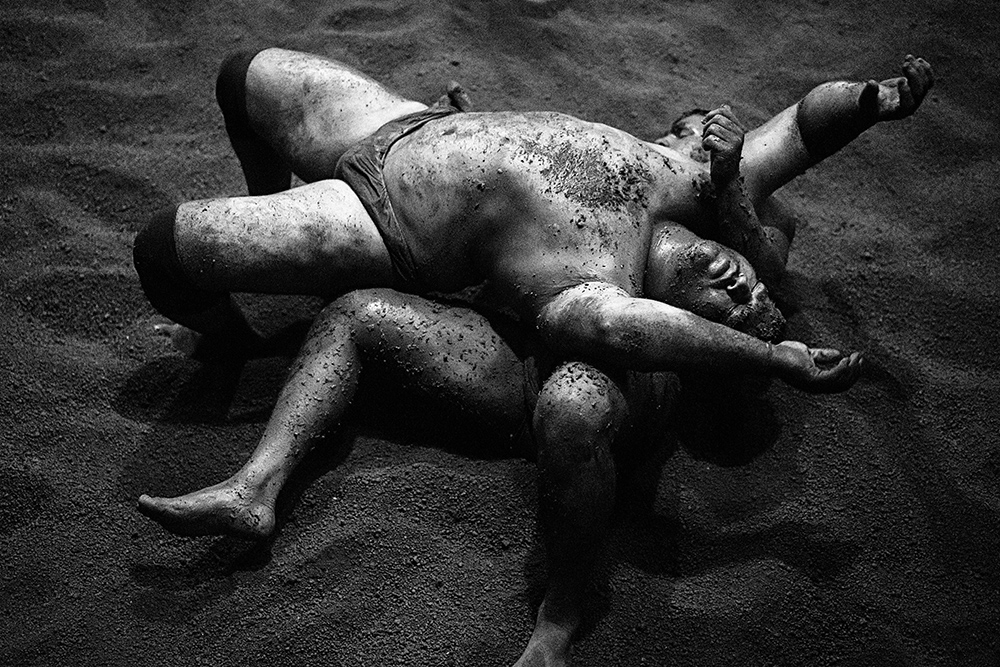
Indian Kushti wrestlers at daily practice in a talim (a wrestling center) in Kolhapur, India. Photographed with a Sony a7R II and Sony FE 55mm f/1.8 ZA Carl Zeiss Sonnar T* lens at ISO 6400 with an f/2.0 aperture and 1/400 second shutter speed. Photo © Benjamin Lowy / Reportage by Getty Images.
AB: I think part of what draws me into some of your sports images is that you use a lot of dark areas in them. They’re fairly low-key. Is that something you do intentionally or intuitively?
Ben Lowy: The whole trip into sports has been kind of a dark journey for me, so it has a gloomy perspective. A lot of why I started it is because I received a PTSD diagnosis, and I was trying to get through it in my own way.
I think the process for me is intuitive, but I also have a very distinct idea of how I’m approaching sports. For the longest time I had problems with saying, “There’s conflict going on, people are dying around the world, and then other people in other parts of the world are just sitting in a stadium cheering.” I remember that when the Iraq war started in 2003, so did baseball season. There was a disconnect. I think about that when I’m watching sports: You have these grand events like the Super Bowl, and so much money is spent on that, and what does that say about our culture or our world?
At the same time, I almost think sports is as an important release valve for the psyche. You need recreation as part of a well-rounded existence. Sometimes the idea of relative realities speaks to me and it makes it easier to photograph, say, the Super Bowl. Other times, I think about how life used to be in Iraq and Afghanistan, and how do I talk about that, without pushing it down anyone’s throat? When you’re a photojournalist or a working photographer, you have to do the job. When you’re an artist, you kind of relate a little bit of yourself to your pictures. I try to straddle the line and do both.
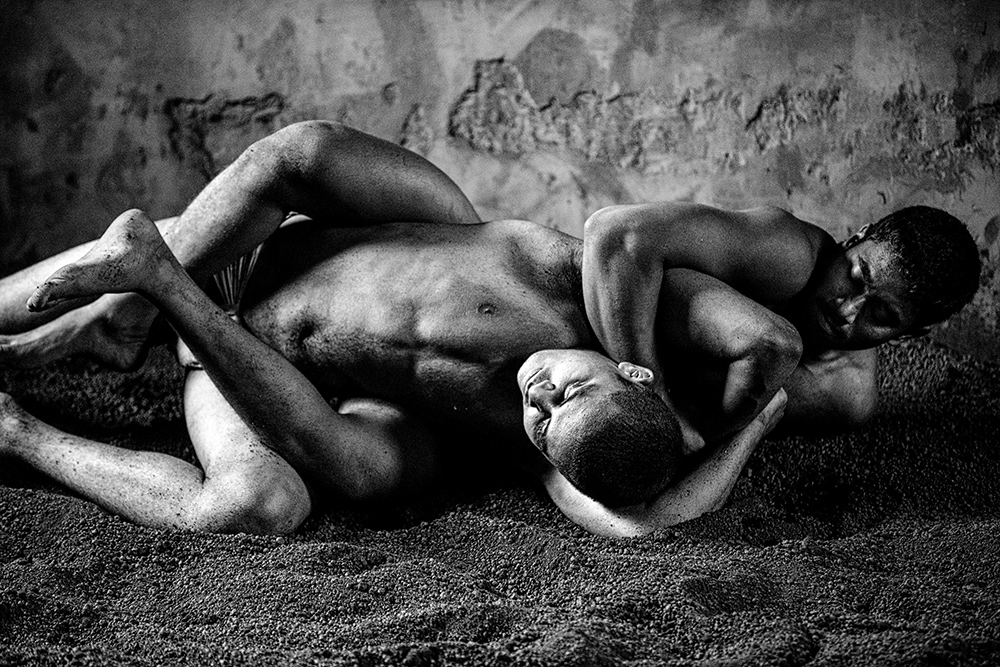
Indian Kushti wrestlers at daily practice in a talim (a wrestling center) in Kolhapur, India. Photographed with a Sony a7R II and Sony 70-200mm f/2.8 OSS lens at ISO 2500 with an f/2.8 aperture and 1/320 second shutter speed. Photo © Benjamin Lowy / Reportage by Getty Images.
AB: Photography is often intended to draw people emotionally closer to its subjects, but taking pictures can also create a distance between them and the photographer. Is that a kind of tension you feel?
Ben Lowy: Different people have different approaches. I love creating a visual narrative to draw in the audience, but sometimes I don’t want to be drawn in myself because it might hinder my ability to tell the story properly. It just depends on the situation.
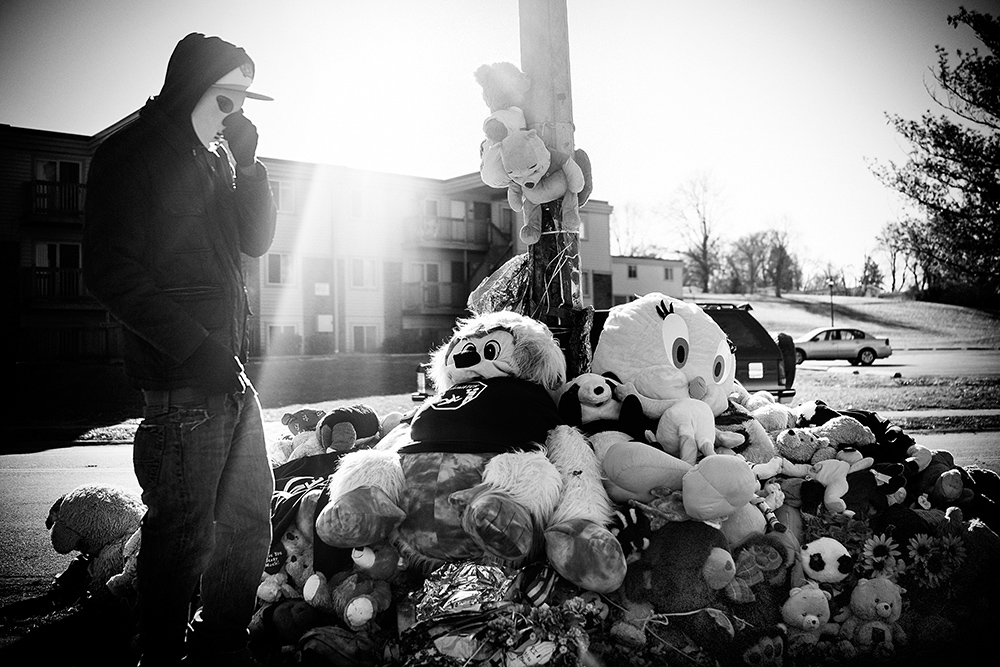
A masked mourner and caretaker spends time at the growing memorial for slain black teen Michael Brown in Ferguson, Missouri. Photographed with a Sony RX1R at ISO 50 with an f/2.0 aperture and 1/1250 second shutter speed. Photo © Benjamin Lowy / Reportage by Getty Images.
AB: I think that’s an issue for a lot of people who photograph difficult subjects. They don’t want their work to create a distance that objectifies people’s suffering.
Ben Lowy: Yes, but you always do, one way or another. You are objectifying people in many ways, and you have to figure out how to reinsert their humanity and not just see people as a mere compositional element in a product you’re creating. I think it’s what you strive for every day.
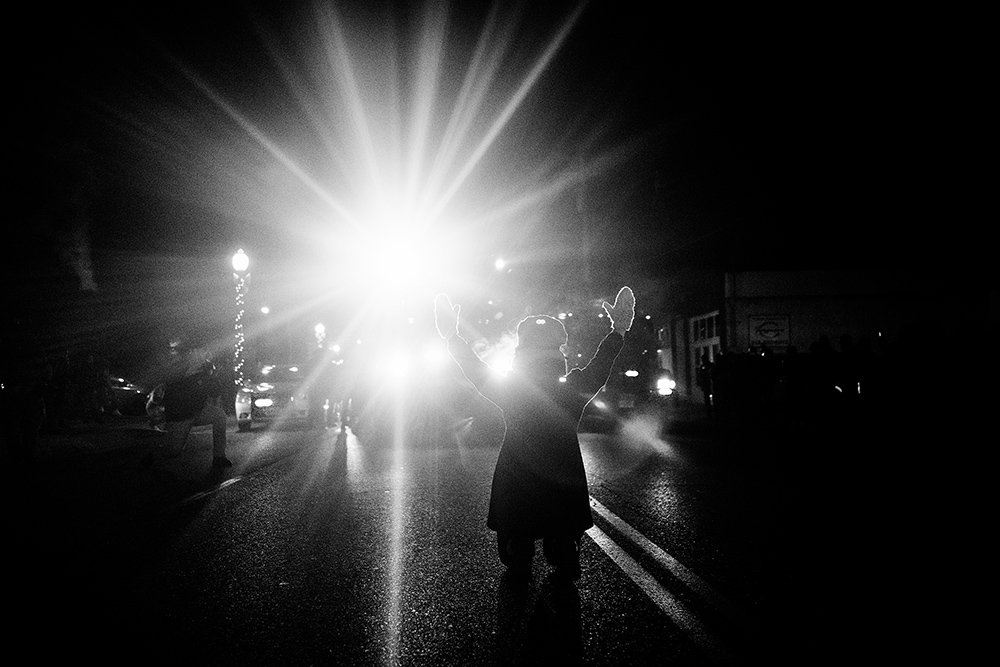
A white protester, ignoring the pleas of her friends, stands in the street, her hands raised daring the police to arrest her, following a violent turn of events as angry protesters touched an unmanned police car parked outside the Ferguson, Missouri, city hall. Photographed with a Sony RX1R at ISO 2500 with an f/2.0 aperture and 1/1600 second shutter speed. Photo © Benjamin Lowy / Reportage by Getty Images.
AB: Why have you chosen to do so much of your work in black and white lately?
Ben Lowy: I very much see the world in color, and a lot of my conflict work is all in color. Colorful images are pretty. I have a strong visual sense and I like making color images, but the idea of the beauty of suffering is tough—should you make beautiful images out of suffering?
In my sports work I’m almost going in a different direction. I want to not make it colorful, and kind of condense it down to the gritty. I want it to just be about the actual act of sports or people’s reaction to what they’re seeing. I want to get rid of the spectacle. You know, it is a spectacle already, so I want to get rid of the distractions that sometimes can be introduced by color.
AB: Making suffering beautiful is one way of getting people to look at suffering.
Ben Lowy: Totally. People love beautiful images. People love that Marlboro Man pretty sunset. That’s one way of connecting. But I think the act of constantly trying to find a beautiful picture in the midst of something horrifying can be psychologically damaging to the photographer. Not necessarily to the public.
Trying to disseminate information and important news to as many readers or viewers as possible is like trying to sell a product. Yet the news is never good. It’s not like selling a car. You’re showing something that people don’t want to look at—human suffering, injustice, tragedy. Trying to make it relatable or at the very least palatable enough so that people will want to know more about the situation is a psychic battle. In my case, on top of telling the story, I try to make the images beautiful, but that’s just like any other advertising. That’s the part that I wrestle with.
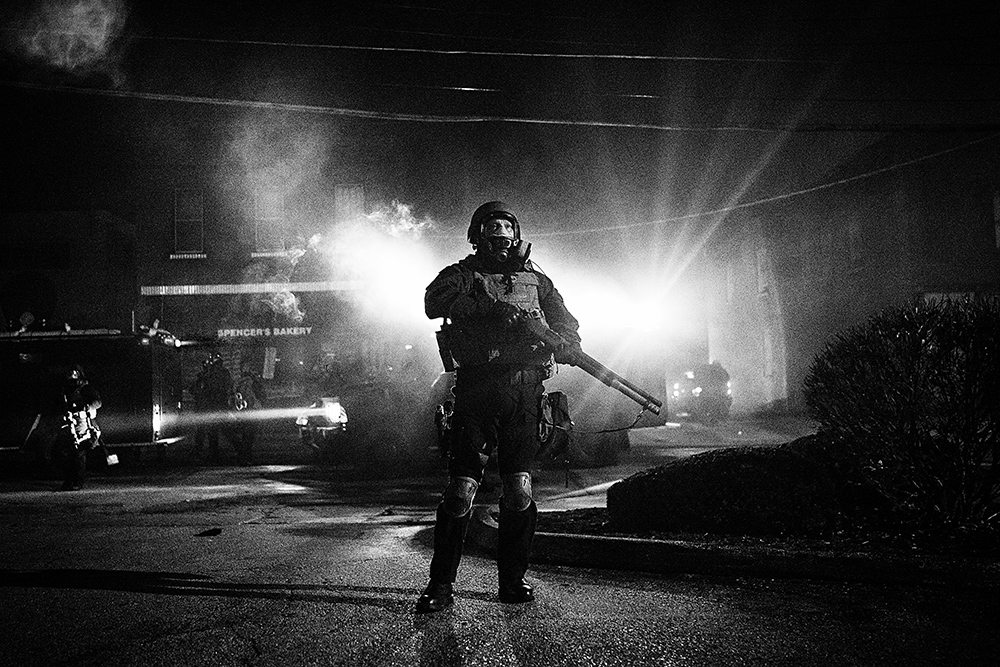
A riot police officer wades into a cloud of tear gas as numerous police units respond to the destruction of a police car parked outside the City Hall in Ferguson, Missouri. Photographed with a Sony RX1R at ISO 2500 with an f/2.0 aperture and 1/250 second shutter speed. Photo © Benjamin Lowy / Reportage by Getty Images.
AB: Tell me about your process when you’re shooting to create black-and-white images.
Ben Lowy: I’m still pushing a raw color file, but I use Alien Skin’s Exposure application. I made a preset to make images look like what I shot in college, which was Fuji Neopan 400 film pushed and developed in Rodinal. I really like that kind of style in black and white, so that’s what I’ve been doing for years now.
AB: Is there anything you do in-camera that’s different from what you do to produce images in color?
Ben Lowy: I expose for my highlights. I find that when converting to black and white, the highlights sometimes can get blown out. I tend in general to underexpose about two-thirds of a stop no matter what I’m shooting at.
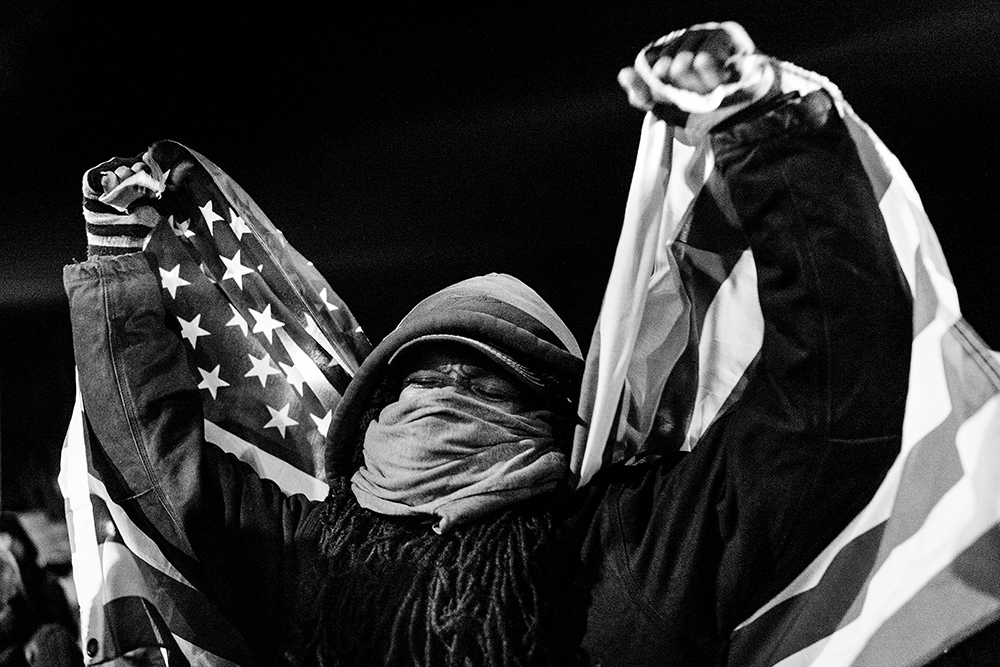
A protester holds the American flag aloft during a protest outside the Ferguson, Missouri, police department the night after riots following the announcement of a grand jury's decision not to indict white police officer Darren Wilson in the death of unarmed black teen Michael Brown. Photographed with a Sony RX1R at ISO 50 with an f/4.0 aperture and 1/640 second shutter speed. Photo © Benjamin Lowy / Reportage by Getty Images.
AB: Where are things going for you? Are you going to continue to cover conflict as well as sports?
Ben Lowy: I have two little kids, and I can’t imagine leaving them. I’ve had people I’ve known, and friends, killed in the last few years. I have this itch and yearning to do conflict work. I know it’s important and I’m mentally capable of doing it. I can put myself in a place like that, where I think not many people can. But, at this point, I just have to wait for the right assignment. There are not a lot of assignments like those these days. It’s something I’d discuss with my wife and figure out if it’s the right fit and the right thing to do.
My plan is to just keep on making images. I’m a photographer. It feeds my soul. I love making images. I don’t put myself into a box anymore and say I have to do certain things because that’s how it is supposed to define me. I am quite aware that I’m lucky. I get great assignments to go to India for a month or go swim with sharks. For me it’s all about these wonderful experiences that I’ve had that feed my curiosity and make life infinitely interesting. I really love that and I want to continue doing it. I don’t know what’s next yet.
I am interested in the root and causes of conflict and the people who are caught in the middle. Conflict has defined my family (my grandparents were refugees). Their experiences were a continuing thread and reminder during my childhood. Conflict affects my life as it’s going forward now, just because of how much time I spent covering it. It is definitely something that interests me and I’ll probably find my way back to it.
For a long time I wanted to be a certain type of photographer. I had this idea I was going to be this monkish kind of photographer and just cover wars my whole life, but I’ve seen other things that are on the polar opposite—births, beauty, the other aspects of life. I just did some wildlife photography and spent the day sleeping next to a puma, and then I went diving with great whites. That’s amazing to me, and it’s all because of the camera! So I can cover the worst parts of humanity, but I still allow myself to be amazed at our most redeeming qualities.
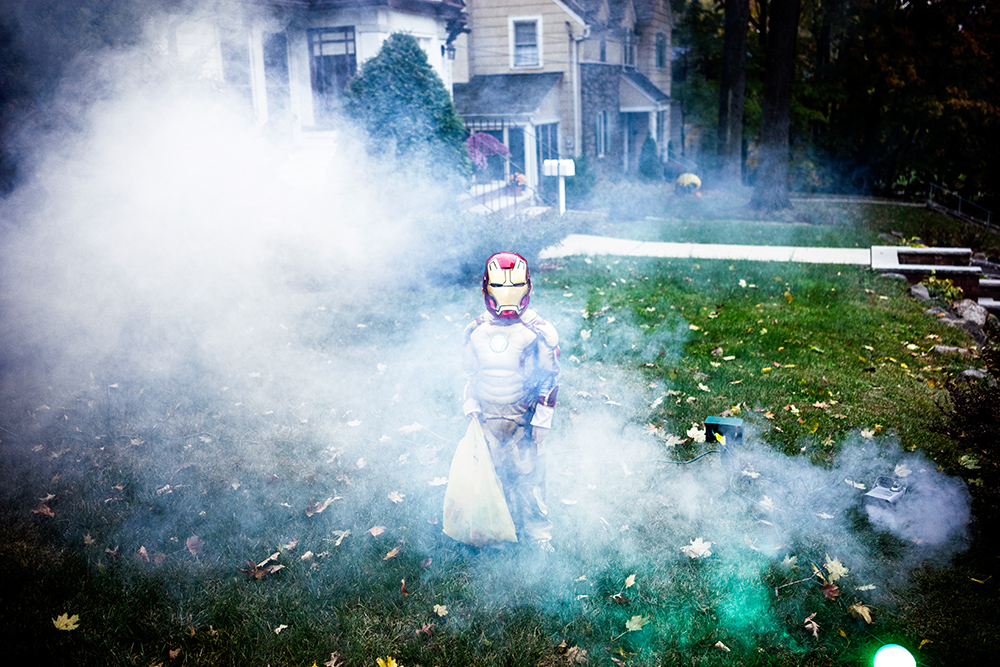
Mateo as Halloween-smoke Iron Man with candy bag; Maplewood, New Jersey. Photographed with a Sony a7R and Sony FE 35mm f/1.4 ZA Zeiss Distagon T* lens at ISO 1000 with an f/3.2 aperture and 1/80 second shutter speed. Photo © Benjamin Lowy / Reportage by Getty Images.
This interview was made possible by support from Sony's Artisans of Imagery program. For more about Ben Lowy, visit his website or find him on Sony's Alpha Universe site.
Want to read more interviews like this one? Check out our other Sony Artisans of Imagery interviews below:
Beat wedding-shoot anxiety: Wedding photography tips from world-class pro Scott Robert Lim
Chasing moonbows: Tips on working with extraordinary light from landscape photographer Don Smith
Fast, far, and wide: Tips for intrepid photographers from adventure sports shooter Gabe Rogel
Background first; the subject can wait: Unusual advice from Nat Geo pro Ira Block